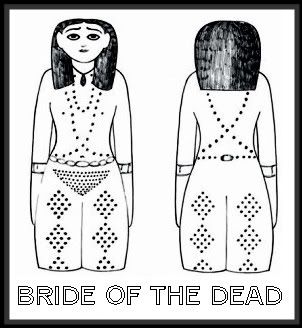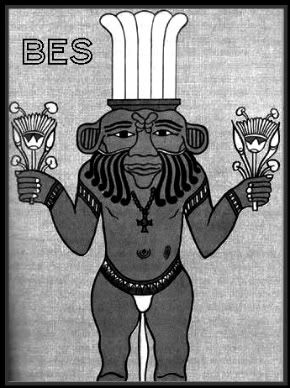Tattoo Advice and History > Tattoo History > Egyptian Tattoos: History of & Influence on Modern Body Art
The History of Egyptian Tattoos and
Their Influence on Modern Day Body Art
People have marked their bodies with tattoos for thousands upon thousands of years. The permanent designs chosen were sometimes elaborate and sometimes nothing more than a line or simple shape. Body modifications and tattoos have meant many things to those who have adorned their skin. Throughout time, tattoos have served as status symbols, declarations of spirituality or bravery, amulets, talisman, forms of punishment, decorative adornments, emblems of security, and much more.
It is believed that tattooing has been around since the Neolithic/Stone Age period. In 1991, Otzi the Iceman, a five thousand year old tattooed man, was found in the Otz Valley in the Alps and bore 57 tattoos on his skin. Lines found on his skin were 15 centimeters long above his kidneys and numerous parallel lines on the ankles; as well as a cross on the inside of his knee. The position of the tattoos showed that they may have been applied for therapeutic reasons, perhaps for arthritis. In regards to recorded history, the earliest tattoos can be found in Egypt during a time that coincides with the construction of the Egyptian pyramids.
The art in ancient Egypt was both highly symbolic and stylized. While much of this art has been found in the form sculptures and paintings, there were more diverse depictions that were left to discover as well. The surviving art has often been discovered in monuments and tombs, carefully placed there by the Egyptians many years ago, as they fulfilled their focus on the preservation of knowledge of the past.
The reason that this is a common area to locate the remnants is the high emphasis that the Egyptians placed on life after death. The symbolism used played an important role in establishing the sense of order within the society. The pharaohs royal rights and privileges could be seen within the symbolism, as could the individual symbols of the Egyptian gods and goddesses. Another important figure in Egyptian symbolism was the use of animals, of which the society held in high regard. The colors used at the time were meaningful and vibrant, rather than natural. Red skin was utilized to represent the youth who often worked outdoors in the sun, whereas many women who were more commonly found indoors were represented with yellow shades. Divinity was indicated by gold or blue pigments, as they were more unusual and were thought to be associated with precious materials. The color black was used when depicting royal figures and was also thought to represent the fertility of the Nile, the river of which Egypt was born from its waters.
Because of the heavy emphasis placed on symbolism, it’s not surprising that skin would become a notable way to exemplify roles and status from within the community as well. Body art found from this time has given researchers an interesting look into the history of this time, serving as a portrait of ideas and a glimpse into the ideals and declarations that they may have found significant.
 AmunetEvidence of tattoos in ancient Egypt were found on a well-preserved female mummy from Thebes known as Amunet. She was a priestess of the goddess Hathor of Thebes (she symbolized the cosmic mother who gave life to all on earth) during the Dynasty XI and was excavated in 1891, by Eugene Grebaut.
AmunetEvidence of tattoos in ancient Egypt were found on a well-preserved female mummy from Thebes known as Amunet. She was a priestess of the goddess Hathor of Thebes (she symbolized the cosmic mother who gave life to all on earth) during the Dynasty XI and was excavated in 1891, by Eugene Grebaut.
When Amunet was found, all of the surrounding tombs had been pillaged, but buried within the Pharaoh’s mortuary temple precinct, in a triangular court in the north corner, was hers. Amunet's wore many collars and necklaces, and her body was tattooed. Because she was probably a concubine, as well as Hathor's priestess, her bandages were marked with the names of the King of Upper and Lower Egypt; Mentuhotep, the Son of Re; as well as other women's names.
Her body was very well-preserved and featured tattoos in abstract patterns. There were dashes and dots tattooed on her body, one was an elliptical pattern found on her lower abdomen, beneath the navel. She had a cicatrix pattern over her lower pubic region. The placement of the tattoos on the abdomen, pubic and pelvic region is thought to validate the belief that the ancient Egyptians used these markings for reproductive protection. They also discovered parallel lines on her thighs and upper arms.
Statues have been discovered of Amunet in many Egyptian tombs that are decorated with designs similar to her tattoos. They are believed to be symbols of regeneration and fertility. These small statues are known as Brides of the Dead and were commonly buried with male mummies.

As time went on, the simplistic patterns of lines and dots progressed into more complex designs. Mummies of dancers that lived around 1500 BCE have been found with the first "picture" tattoos on their thighs. These abstract picture designs are thought to have represented Bes, the god of revelry in Egyptian mythology and the patron god of musicians and dancing girls. Bes tattoos have also been found on female Nubian mummies. It is believed that the tattoos of Bes were markings which were used for protection during pregnancy and birth.
As an amulet, it was the hope that Bes would provide easy childbirth, as well as help with both conception and to protect the woman for future pregnancies. Because the pictorial imagery of tattooed women commonly featured musicians, dancers, and acrobats, some believed that the tattoos might have perhaps been tattooed on women who were prostitutes, to protect against venereal diseases. But this assumption is not widely followed nowadays and may have been started in relation to the bias of tattoos by many in society. Because tattoos were considered taboo for many years, there was an automatic association among some early anthropologists that these ancient tattooed women must have been deviant for some reason. But research has shown that the reasons were probably far from this old way of thinking.

The ink used in these early tattoos is believed to have been made from a type of soot, as it was usually dark, either black or black-blue in color. Many types of instruments have been found that are considered to be the means by which the tattooers pricked the skin and inserted the ink.
Only female Egyptian mummies have been found with tattoos, but it is not believed that only females were tattooed, as there have been many pieces of Egyptian artwork discovered that depict males with tattoos as well.
Archaeologists are constantly searching for new treasures to help us unlock the secrets of the past. The understanding of these ancient mysteries help us to learn more and are a compelling force in the culture of society today. Because of this rich history of ancient Egypt, the effect has been profound and can be clearly seen in modern day tattooing and styles. The history, culture, religion, architecture, and people of Egypt have influenced many ink collectors who head to the tattoo chair today.
The lore and intrigue of this time in history is easy to find when studying tattoos that are commonly tattooed each day. Hieroglyphics are often employed to tell stories and relay personal journeys through ink designs - from images of the past, to ideas for the future. The sphinx is also commonly used as a focal point, as is the phoenix, of which the Egyptians had their own interpretation of, symbolizing rebirth, particularly of the sun.
In addition, gods, goddesses, pharaohs, and the sun itself are very common themes in modern day tattoo work. These designs rely heavily on the beautiful Egyptian style of artwork and can be seen tattooed in the traditional form, or altered to fit a more custom-designed piece.
Some of the historical Egyptian subjects often seen in modern day tattoos include:
- Osiris: also known as Usiris, he was an Egyptian god, serving as the ruler of the afterlife, the underworld, and the dead. Osiris was first noted in the middle of the Fifth dynasty of Egypt. Many of the myths of Osiris are derived from symbolic information in the Pyramid Texts. For the dead in the afterlife, Osiris was known as a merciful judge and is said to have granted life in the underworld, which includes the vegetation for the fertile Nile River. He has also been known as the "Lord of Love."
- Isis: an ancient Egyptian goddess whose worship spread throughout the Greco-Roman world. She was worshipped as the matron of nature and magic, and seen as the ideal mother and wife. Isis was the friend of artisans, sinners, slaves, and the oppressed. She was also known to listen to the prayers of maidens, rulers, aristocrats, and the wealthy.
- Bastet: the daughter of the Sun God Ra, the Bastet was a woman with the head of a cat. She is known as the feline goddess of ancient Egyptian religion. Cats in ancient Egypt were commonly worshipped and revered.
- Amun: a God in Egyptian mythology, Amun was a man with a ram head and was one of the most powerful of the Egyptian gods. He was known to help the poor and unfortunate; and was said to be self-created (because of this, he was known as the grandest of the transcendental deities in Egyptian theology).
- Horus: one of the most notable and significant of the ancient Egyptian deities, it is believed that Horus was worshipped from the late Predynastic period through Greco-Roman times. Horus was depicted in the form of a falcon and was the patron deity of Nekhen in Upper Egypt. Horus was commonly known as the Lord of Life. In Egyptian hieroglyphs, Horus was shown as h.r.w (pronounced *H.a-ru - which means "falcon")
- Ankh: was known as the key of life or the key of the Nile. The ankh was the ancient Egyptian hieroglyphic character which meant "eternal life" and was said to offer protection.
- Tutankhamen: also known as King Tut, he was known as the Egyptian pharaoh of the 18th dynasty. Tutankhamen translates to the "Living Image of Aten;" while Tutankhamun means "Living Image of Amun." He is perhaps the most well-known pharaoh and his well-preserved tomb is among one the most exhibited of all Egyptian artifacts.
- Sphinxes: creatures with a lions body and a human head, sphinxes were associated with solar deities in ancient Egyptian history. The Egyptian name for sphinx was "shesepankh," which meant "living image," and referred to the statue of the sphinx, which was carved out of "living rock."
The above are just a small array of images and figures which can commonly be seen in tattoo designs. While there are various interpretations for each and they oftentimes take on brand new meanings to those collectors who chose to wear them, the history of which they are chosen certainly abounds in value and significance.
Just as the tattoos found on the mummy Amunet revealed symbols of allusion and whose well-preserved patterns indicated stories of her time, so do the modern day designs which carry on the tradition of perseverance and volition to the ink collectors who proudly wear the treasures upon their skin.

Last updated on September 21, 2010 by Jinxi Boo




